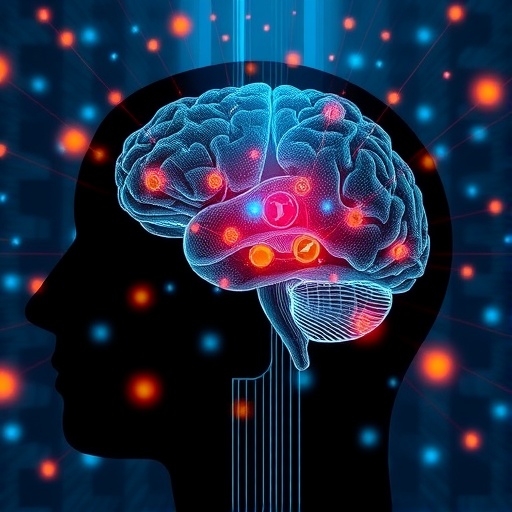In the intricate orchestra of the brain, information flows through myriad pathways, orchestrated by rhythmic patterns of neural activity that span multiple frequencies. A groundbreaking study, spearheaded by Claudio Mirasso at the Institute for Cross-Disciplinary Physics and Complex Systems (IFISC) and Santiago Canals at the Institute for Neurosciences (IN), has unraveled how the brain dynamically selects routes to process information by modulating the balance between two pivotal inhibitory circuits. Published in PLOS Computational Biology, this work radically reshapes our understanding of neural communication and cognitive flexibility.
At the core of this research lies the interaction between slow and fast brain rhythms—namely theta and gamma oscillations—that coordinate neural ensembles during cognitive functions. Traditionally, neuroscientists believed that slow oscillations orchestrate the amplitude modulation of faster rhythms in a unidirectional fashion, effectively gating when and how information is processed. However, this new study reveals a bidirectional relationship: not only do theta waves regulate gamma activity, but gamma rhythms also influence theta oscillations, with this intricate interplay being sculpted by two distinct forms of inhibition—feedforward and feedback inhibition.
Using a unique fusion of computational modeling and electrophysiological recordings, the researchers focused on the hippocampus, a region paramount for memory formation and spatial navigation. Their experimental data, obtained from rats navigating novel and familiar environments, demonstrate that the brain flexibly switches between communication modes depending on context. In familiar settings, feedforward inhibition predominates, promoting gamma-to-theta interactions that prioritize reactivation of stored memories by channeling sensory information directly from the entorhinal cortex to the hippocampus. Conversely, when encountering novelty, feedback inhibition arises, fostering theta-to-gamma coupling that integrates incoming sensory input with memory traces, enabling the updating of stored representations.
This continuous transition between inhibitory modes hinges critically on synaptic strength and connectivity within neural circuits. Unlike a binary switch, the balance between feedforward and feedback inhibition is fluid, allowing the brain to finely tune its processing strategies in real-time to meet cognitive demands. Such flexibility embodies an elegant neural mechanism by which the brain configures its internal communication architectures according to situational exigencies.
“In contrast to the long-held notion that brain rhythms are strictly hierarchical and unilateral in their interactions, our findings uncover a dynamic, bidirectional dance,” explains Dimitrios Chalkiadakis, the study’s first author. “By adjusting inhibitory influences, neural circuits effectively ‘choose’ which information streams to prioritize—whether recalling past experiences or engaging with novel sensory inputs.”
Delving deeper into the mechanistic underpinnings, the computational framework developed by the team simulates the delicate balancing act of inhibitory neurons modulating excitatory pathways. Feedforward inhibition typically targets principal cells soon after they receive input, serving as a rapid gatekeeper, while feedback inhibition arises from the activation of local interneurons that reciprocally regulate those same principal cells. This dual inhibitory architecture orchestrates the directionality of cross-frequency coupling, shaping the theta-gamma code believed to underpin complex cognitive functions.
The implications of this research extend far beyond memory and navigation. Since similar oscillatory interactions also appear in attentional processes, the flexible modulation of inhibitory circuits could represent a fundamental principle governing how the brain allocates computational resources among competing demands. Emerging human neurophysiological data support this view, revealing patterns congruent with the computational insights derived from rodent models.
Furthermore, this study provides a unifying framework reconciling previously conflicting theories regarding the origin and modulation of brain rhythms. Rather than being solely intrinsic to local circuits or inherited from upstream regions, theta and gamma oscillations emerge from an interplay between external inputs and the fine-tuned local inhibitory dynamics, a dual mechanism that heightens the brain’s adaptive prowess.
Looking ahead, the authors aim to extend their models to encompass the immense heterogeneity of neuronal types and architectures that characterize different brain regions, striving for a comprehensive understanding of how inhibitory balance modulates cognition at large. This expanded perspective holds promise for elucidating pathological states as well—disorders like epilepsy, addiction, and Alzheimer’s disease, characterized by dysregulated inhibition and oscillatory abnormality, may benefit from mechanistic insights gained through such studies.
By dissecting the biophysical and computational principles governing inhibitory control over brain rhythms, this research not only deepens fundamental neuroscience but also opens avenues for novel therapeutic strategies. Targeting the precise inhibitory balances that gate information flow could pave the way for interventions to restore cognitive function in neurological and psychiatric conditions.
Bolstered by funding from the Spanish Ministry of Science, Innovation, and Universities and the Spanish State Research Agency, the study exemplifies international, cross-disciplinary collaboration at the interface of physics, computational modeling, and experimental neuroscience. It underscores the power of integrating theory with empirical data to decode the brain’s dynamic language.
In sum, Mirasso, Canals, and colleagues reveal a mesmerizing choreography within the neural substrate, whereby inhibitory circuits flexibly steer the brain’s internal conversation. This discovery heralds a paradigm shift, illuminating how the brain’s rhythmic symphony adapts its flow of information to navigate the demands of memory, novelty, attention, and beyond.
Subject of Research: Not applicable
Article Title: The role of feedforward and feedback inhibition in modulating theta-gamma cross-frequency interactions in neural circuits
News Publication Date: 13-Aug-2025
Web References: http://dx.doi.org/10.1371/journal.pcbi.1013363
References: Chalkiadakis, D., et al. 2025. Instituto de Neurociencias UMH CSIC
Image Credits: Chalkiadakis, D., et al 2025. Instituto de Neurociencias UMH CSIC
Keywords: Brain structure




